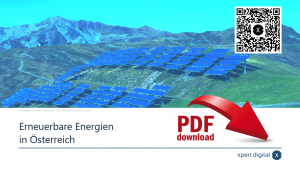PV system 750 kWp and more – open-air system / open-space system / solar park
Language selection 📢
Published on: March 6, 2021 / update from: August 4, 2021 - Author: Konrad Wolfenstein
Again and again I am asked what a 750 kWP photovoltaic (PV) system or solar system “approximately” brings comparatively to performance and how much households can be supplied with it.
There are many factors that play a role in being able to make a final, reliable statement.
Above all, the location for solar radiation, the size of an open-space photovoltaic system and the performance of the solar modules used play an important role. In general, the solar modules should also be oriented southwest to southeast and with an inclination of 20 to 40 degrees. It is also important that shading from the surrounding area is avoided. Brightness and temperature influence the performance of solar installations.
The examples given here are only a guideline and should help you get a better idea.
I therefore always recommend that you contact me directly so that you can provide a detailed analysis and more detailed information. I would also be happy to help private individuals whom I can help with Xpert.Solar, either via the area search on the website or through a direct recommendation from me. I can also support companies from trade and industry with my consulting services and the right partners, from manufacturers to electrical companies and solar installers.
Suitable for:
How do kWp and kW differ?
Watt Peak (English Peak “Space”) is a name for the electrical performance (unit: watts) of solar cells in the field of photovoltaics but not standard. Multiple such as kilowatts peak, megawatts peak and gigawatt peak are also used. WP, KWP, MWP or GWP are used as abbreviations. The unit serves to compare different solar cells and solar modules under standardized test conditions.
Formulations such as “The photovoltaic system has an output of 10 kWp” or “This is a 1.2 MWP open space solar system” are colloquially. Formally correct it should be “The photovoltaic system has a nominal output according to the standard test conditions of 10 kW” or “This is a 1.2 MW open space solar system (nominal output according to the standard test conditions)”.
Kilowatt peak is therefore used exclusively for measuring and comparing photovoltaic systems and photovoltaic modules. A solar module delivers different outputs under changing conditions, such as different outside temperatures.
The statement “An area of approximately 6 to 10 m² is required per 1 kWp” means that an area of approximately 6 to 10 m² is required for a desired system output of 1 kW under standard test conditions.
Accordingly, the spelling “1 kW” for photovoltaic systems of the spelling “1 kwp” is preferable, since an addition of additives to unit signs is not standard.
In short: 1 kWp ≙ 1 kW ≙ 1,000 Wp ≙ 1,000 W
And what is the connection between kWh and kWp?
Kilowatt hours (kWh) indicate the actual amount of electricity (generated/consumed) per hour, kilowatt peak indicates the possible output under standard test conditions.
What can 1 kWh do or what can you do with 1 kWh?
With 1 kWh you can e.g. B. Watch TV for 7 hours, wash 1 full washing machine at 60° or cook food for 4 people. 1 hour of vacuuming or 2,500 men can shave electrically.
Or: Drive around 6.7 kilometers in an electric car (with an average energy requirement of 15 kWh per 100 km).
According to electricity mirror statistics, a one-person household consumes an average of 2,300 kilowatt hours (kWh) per year.
A 2-person household is 3,200 kWh, a 3-person household is 3,900 kWh and a 4-person household is 4,500 to 5,000 kWh. The values can vary depending on your living circumstances.
How many modules are required for 1 kWp or 1 kW?
As a standard starting value, I currently still use the length and width of a solar module with a module output of 185 Wp and measuring 1580 x 808 cm. That's around 1.28 m² per module.
185 Wp is of course calculated very conservatively. Polycrystalline models achieve a nominal output of up to 330 Wp. Monocrystalline modules, on the other hand, now come with up to 400 Wp or even more.
For a 750 kWp PV solar field system, 4,054 solar modules with a nominal output of 185 Wp are required. Exactly half less if solar modules with a nominal output of 370 Wp are used. This only requires half the area. Here, too, you can see what you have to take into account and proper advance planning is only recommended.
But let's go back to our example for simplicity:
1,000 Wp / 185 Wp ≙ rounded up 6 (5.4054…) modules.
6 modules give an area of 7.68 m².
For 1 kW or kWp we need the power of 6 modules on an area of 7.68 m², for example to be able to cook food for 4 people.
On average, 1 kWp delivers 1,000 to 1,200 kWh per year.
How many modules does a 4-person household need throughout the year?
With an annual requirement of 5,000 kWh, that would be a daily requirement of 13.7 kWh per day (calculated 365 days a year). That would be 0.57 kWh per hour. But that's not enough to cook food, use the television and all the other electricity needed for everyday things at the same time.
Therefore, a size of 6-7 kWp is recommended for a 4-person household: With 6 modules (each with 185 Wp nominal power) for 1 kW, that would be 36-42 modules. With 3 modules (each with 370 Wp nominal power) that would be 18-21 modules.
Much of what has been listed here are only guidelines and usually do not correspond to the actual individual reality of the individual. There are simply too many aspects that need to be taken into account to be able to provide precise information and planning. It's just meant to help you understand the numbers better and get a feel for them.
How many households can be supplied with a 750 kWp ground-mounted PV system?
A 750 kWp solar park can produce up to 900,000 kWh of electricity per year (1 kWp up to 1200 kWh per year * 750). You have to know that a 1 kWp photovoltaic system located in Germany can generate an average of around 1,200 kWh annually.
Taking into account the different households of 1 to 4 people, up to 230 households can be supplied.
Mathematically, 180 4-person households (900,000 kWh / 5000 kWh) are possible, 280 2-person households or 230 3-person households.
As already mentioned above, more households are possible when using modules with a higher nominal power than 185 Wp! With a nominal output of 370 Wp per module, for example, that would be twice as many households. But then it is no longer a 750 kWp ground-mounted photovoltaic system , but a 1.4 MWp ground-mounted system.
With Xpert.Solar we offer consulting services for companies planning a photovoltaic system.
What are your advantages?
- A personal contact with individual advice. This also applies to advice and on-site inspections.
- We bring you together with long-standing solar experts and manufacturers in the industry.
- This saves you time searching for suitable experts.
- The consulting services are non-binding for you!
- All services according to your wishes.
- As consultants and solution providers, we are available to answer any questions and problems you may have at any time.
- You have the projects and the areas, we have the solutions. From the assembly system to power storage and inverters to the modules.
- If something doesn't fit, we will develop project-specific special solutions for you.
- If you wish, we can organize your photovoltaic projects and the construction site for you. Whether piling work, frame or module assembly, DC/AC assembly and renovations.
- As your partner, we support you in planning module occupancy, shading calculation, string planning and occupancy as well as in the creation of plans and drawings.
- We help and support everything from soil reports to planning and static calculations.
- Safety is our top priority. An all-round service too. We can do a variety of things for you. Whether soil reports, project statics, snow load reports, acceptance or damage reports.
- Increasingly important: the safety and protection of your solar system. If necessary, we will create a security concept for you.
- We make your life a little easier and give you time.
- We help you and support you in your work.
- We combine quality with effectiveness.
That's why Xpert.Solar for PV outdoor systems / open space systems / solar parks Advice and planning of 750 kWp and more
Xpert.Solar is a project from Xpert.Digital. We have many years of experience in supporting and advising on storage solutions and in logistics optimization, which we bundle in a large network Xpert.Plus With Xpert.Solar we combine the same know-how in the areas of photovoltaics and renewable energies.
If you wish, you can also access our large market observation and market intelligence data in the form of PDFs. More about that here .
I would be happy to serve as your personal advisor.
You can contact me by filling out the contact form below or simply call me on +49 89 89 674 804 (Munich) .
I'm looking forward to our joint project.
Large PDF library: Market monitoring and market intelligence on the subject of photovoltaics
Photovoltaics in Germany
- Photovoltaics in Germany – PDF download
- Energy market in Germany – PDF download
- Electricity market in Germany – PDF download
- Energy transition in Germany – PDF download
- Smart Grid in Germany – PDF Download
Austria
- Renewable energies in Austria – PDF download
- Electricity market in Austria – PDF download
- Energy market in Austria – PDF download
Switzerland
- Energy market in Switzerland – PDF download
- Electricity market in Switzerland – PDF download
- Statistics on renewable energies in Switzerland – PDF download
More
- Sustainable investments in the energy sector – PDF download
- Energy storage – PDF download
- Silicon – PDF Download
- Smart City DE – PDF Download
Worldwide and various – partly in English
- Renewable energy in China – PDF download
- Solar PV in Europe – PDF Download
- Solar PV in France – PDF Download
- Renewable energy in Australia – PDF Download
- Smart grids in the USA – PDF Download
- Energy storage – PDF download
- Lithium industry worldwide – PDF download
- Global solar photovoltaic industry – PDF Download
- Global Electricity – PDF Download
- Renewable energies worldwide – PDF download
Solar module manufacturer
- Canadian Solar – PDF
- First Solar – PDF Download
- JinkoSolar – PDF Download
- SolarCity – PDF Download
Xpert.Digital – Konrad Wolfenstein
Xpert.Digital is a hub for industry with a focus on digitalization, mechanical engineering, logistics/intralogistics and photovoltaics.
With our 360° business development solution, we support well-known companies from new business to after sales.
Market intelligence, smarketing, marketing automation, content development, PR, mail campaigns, personalized social media and lead nurturing are part of our digital tools.
You can find out more at: www.xpert.digital – www.xpert.solar – www.xpert.plus


























































